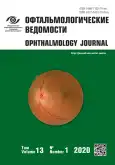The influence of concomitant glaucoma on iol power calculation accuracy
- Authors: Belov D.F.1, Nikolaenko V.P.1,2
-
Affiliations:
- Saint Petersburg State Hospital No. 2
- Saint Petersburg State University
- Issue: Vol 13, No 1 (2020)
- Pages: 5-9
- Section: Original study articles
- URL: https://journals.rcsi.science/ov/article/view/19025
- DOI: https://doi.org/10.17816/OV19025
- ID: 19025
Cite item
Abstract
Aim. To estimate the influence of concomitant glaucoma (including that after surgery) on IOL power calculation accuracy before phacoemulsification.
Materials and methods. 413 patients were included in the study divided in 4 groups: 1st – patients with cataract and no concomitant glaucoma (251 cases); 2nd – patients with cataract and primary open-angle glaucoma (POAG) on medical therapy (103 cases); 3rd – patients with cataract and prior trabeculectomy (42 cases); 4th – patients with cataract and primary angle-closure glaucoma (PACG) on medical therapy (17 cases). In all patients, the IOL power calculation was performed using optical biometry (IOL-Master 500). 1 month after surgery, desired refraction according to Barrett Universal II Formula and real obtained refraction estimated by automatic refractometry (Topcon-8800) were compared.
Results. There was no significant difference between study groups 1–3 in IOL power calculation accuracy (the calculation error was –0.09 ± 0.39 D, –0.08 ± 0.45 D, –0.03 ± 0.49 D, for each group respectively). However, we found a higher myopic shift (–0.47 ± 0.48 D, p = 0.095) in the 4th group.
Conclusion. The presence of concomitant POAG on medical therapy, same as earlier trabeculectomy, does not demand any modification of the IOL calculation algorithm. However, in PACG patients we recommend taking –0.5 D lower optical power IOLs to avoid excessive myopic refraction after phacoemulsification.
Keywords
Full Text
##article.viewOnOriginalSite##About the authors
Dmitrii F. Belov
Saint Petersburg State Hospital No. 2
Author for correspondence.
Email: belovd1990@gmail.com
Ophthalmic Surgeon. Microsurgery Department No. 4
Russian Federation, Saint PetersburgVadim P. Nikolaenko
Saint Petersburg State Hospital No. 2; Saint Petersburg State University
Email: dr.nikolaenko@mail.ru
MD, PhD, Professor, Otorhinolaryngology and Ophthalmology Chair of Medical Faculty
Russian Federation, Saint PetersburgReferences
- Melles RB, Holladay JT, Chang WJ. Accuracy of intraocular lens calculation formulas. Ophthalmology. 2018;125(2):169-178. https://doi.org/10.1016/j.ophtha.2017.08.027.
- Cook C, Foster P. Epidemiology of glaucoma: what’s new? Can J Ophthalmol. 2012;47(3):223-226. https://doi.org/10.1016/j.jcjo.2012.02.003.
- Gale RP, Saldana M, Johnston RL, et al. Benchmark standards for refractive outcomes after NHS cataract surgery. Eye (Lond). 2009;23(1):149-152. https://doi.org/10.1038/sj.eye.6702954.
- Law SK, Riddle J. Management of cataracts in patients with glaucoma. Int Ophthalmol Clin. 2011;51(3):1-18. https://doi.org/10.1097/IIO.0b013e31821e58aa.
- Li S, Hu Y, Guo R, et al. The effects of different shapes of capsulorrhexis on postoperative refractive outcomes and the effective position of the intraocular lens in cataract surgery. BMC Ophthalmol. 2019;19(1):59. https://doi.org/10.1186/s12886-019-1068-3.
- Lister LJ, Suheimat M, Verkicharla PK, et al. Influence of gravity on ocular lens position. Invest Ophthalmol Vis Sci. 2016;57(4): 1885-1891. https://doi.org/10.1167/iovs.15-18533.
- Muniz Castro H, Tai AX, Sampson SJ, et al. Accuracy of intraocular lens power calculation using anterior chamber depth from two devices with barrett universal II formula. J Ophthalmol. 2019;8172615. https://doi.org/10.1155/2019/8172615.
- Olsen T. Sources of error in intraocular lens power calculation. J Cataract Refract Surg. 1992;18(2):125-129. https://doi.org/10.1016/s0886-3350(13)80917-0.
- Pakravan M, Alvani A, Esfandiari H, et al. Post-trabeculectomy ocular biometric changes. Clin Exp Optom. 2017;100(2):128-132. https://doi.org/10.1111/cxo.12477.
- Pakravan M, Alvani A, Yazdani S, et al. Intraocular lens power changes after mitomycin trabeculectomy. Eur J Ophthalmol. 2015;25(6):478-482. https://doi.org/10.5301/ejo.5000604.
- Paletta Guedes RA, Paletta Guedes, VM, Aptel F. [Multifocal, toric, and aspheric intraocular lenses for glaucoma patients. (In French)]. J Fr Ophtalmol. 2011;34(6):387-391. https://doi.org/10.1016/j.jfo.2011.02.003.
- Popa-Cherecheanu A, Iancu RC, Schmetterer L, et al. Intraocular pressure, axial length, and refractive changes after phacoemulsification and trabeculectomy for open-angle glaucoma. J Ophthalmol. 2017;1203269. https://doi.org/10.1155/2017/1203269.
- Scholtz SK, Langenbucher A. [Calculating the human eye – the evolution of biometry for cataract surgery. (In German)]. Klin Monbl Augenheilkd. 2019. https://doi.org/10.1055/a-1002-0136.
- Vander Mijnsbrugge J, Fils JF, Jansen J, et al. The role of the vitreous body in effective IOL positioning. Graefes Arch Clin Exp Ophthalmol. 2018;256(8):1517-1520. https://doi.org/10.1007/s00417-018-3994-9.
- Zhang N, Tsai PL, Catoira-Boyle YP, et al. The effect of prior trabeculectomy on refractive outcomes of cataract surgery. Am J Ophthalmol. 2013;155(5):858-863. https://doi.org/10.1016/j.ajo.2012.11.023.
Supplementary files








